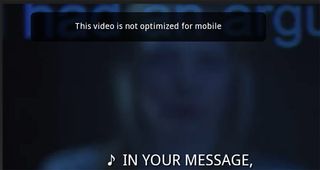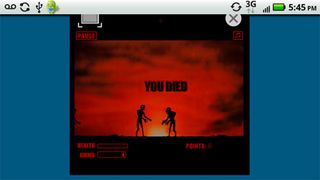Mobile Flash Fail: Weak Android Player Proves Jobs Right

I'm the last person on earth who wanted to believe Steve Jobs when he told Walt Mossberg at D8 that "Flash has had its day." I took it as nothing more than showmanship when Jobs shared his thoughts on Flash and wrote that "Flash is closed and proprietary, has major technical drawbacks, and doesn’t support touch based devices." After spending time playing with Flash Player 10.1 on the new Droid 2, the first Android 2.2 phone to come with the player pre-installed, I'm sad to admit that Steve Jobs was right. Adobe's offering seems like it's too little, too late.
At LAPTOP, we're still testing mobile Flash on a variety of handsets, but the early returns are a mixed bag, with some sites performing really well and other "unoptimized" videos and games causing restless thumb syndrome. When Flash 10.1 for Android is good, it's great, but when it's bad, it can make even the harshest Apple critic want to e-mail Steve Jobs an apology video playing in HTML 5.
To see mobile Flash at its best, I downloaded the Abobe Flash showcase for mobile in the Android Market, a directory of sites the company recommends. There I found a link to the Sony Pictures trailer site, and all of the clips played smoothly at full screen. I also found links to a number of TV shows that play in Flash, but not always smoothly. An episode of CSI on CBS.com didn't cause any serious problems, but it was a bit jerky, particularly at full screen.
Despite the jerkiness, I was excited to be able to watch shows on my phone that previously played only on my PC. That excitement turned to disappointment when I ventured onto several sites that weren't featured in the showcase.
When I went to ABC.com and tried to play a clip, I waited five minutes while the player said "loading." During that time, it was nearly impossible to scroll around the page or tap objects on it. Eventually, I scrolled up to see a message that was previously obstructed and said "Sorry. An error occurred while attempting to load the video. Please try again later." It gets worse...
When I visited Fox.com and tried to start an episode of House, the program actually played but, even over Wi-Fi, the playback was slideshow-like. Worse still, the player became unresponsive as it ignored my attempts to tap the pause, volume, and slider buttons. At some point during playback, an overlay message warned me that this video was "not optimized for mobile." I encountered the same message when I tried to play a trailer of the Expendables that was embedded on the movie's mySpace page. Wasn't Flash 10.1 supposed to erase the boundaries between mobile and the desktop?

During these Flash lockups, it was nearly impossible to scroll around the screen and most taps were ignored or followed many seconds later. The only way I found to get your phone back to normal when it's having a Flash meltdown like this is to hit the back button or the home button to get out of the program and even then the phone takes a second to become responsive again.
Stay in the know with Laptop Mag
Get our in-depth reviews, helpful tips, great deals, and the biggest news stories delivered to your inbox.
The difference between the smooth Flash trailers on Sony.com, the slightly jerky episode of CSI, and the system-stalling Flash video on Fox.com is that the smoother ones were optimized specifically for phone playback. But if content providers have to go back and optimize their videos for mobile platforms, one of the key benefits of mobile Flash--backward compatibility with millions of existing videos--is lost. If you're modifying your videos anyway, why not go the full monty and use an HTML 5 player instead of Flash?
Back in April, Jobs pointed out that mobile Flash had been promised and delayed since the beginning of 2009. "We think it will eventually ship, but we’re glad we didn’t hold our breath," he wrote. Unfortunately, many Web content providers haven't been holding their breath either. As we surfed around, we found more and more sites that work with HTML 5 or other non-Flash technologies. The difference between one video format and another is so slight you can't tell. I visited South Park Studios on my PC and saw that it used Flash to play episodes of the popular show, so I tried it on my phone. I was pleasantly surprised at how well Flash episodes of South Park streamed over 3G, until I realized that the site had detected that I was on my phone and was serving me a specially optimized non-Flash video player (like the YouTube app) instead.
After my mixed experience with video, I was curious to try Flash-based games on our Android phones. When I tried going to famous Flash game sites like Newgrounds or Addicting Games, I found that, as Steve Jobs said, "Flash was designed for PCs using mice, not for touch screens using fingers." Many of the games I loaded were slow to start and slowed the system, making it difficult to scroll around the page or tap on links. But much worse was that, even when these titles loaded, there was no way to control most of the action. Most games required keyboard or mouse actions I simply could not perform on my phone, even with its QWERTY slider. One shooter wanted me to hit the CTRL key to fire; another asked for the left mouse button.
Finally, I went to Mochi Games, a site that Adobe points to from its Flash showcase, a site that is designed specifically for mobile flash. There, I found an attractive looking zombie game called Blood Red that was made for touch and required me to tap the screen to fire my gun at the oncoming undead. Unfortunately, when I tapped my shots went all over the place and I was dead within seconds. Was it Flash that caused the bullets I shot to go to places I didn't tap or was it my poor hand-eye coordination? I don't know, but I was frustrated.

Aside from playing videos and gaming, another purported benefit of Flash is that gives you the real web, without showing empty boxes on your favorite sites. While I love this idea, I actually found that some Flash sites had more difficulty loading on the mobile browser when I had the plug-in enabled. At one point, for a period of about 45 minutes, I was inexplicably unable to load either New York Times home page or LAPTOP's home page as the Droid 2's browser got stuck at the point where it was trying to download some Flash ads and a Flash video player.
When we ran our phone battery test, which surfs the Web until the handset's battery dies, the whole process crashed when the browser reached Veoh.com, a site with an autoplaying Flash video on its home page. Once we disabled Flash, we were able to run the test to completion.
Despite all the problems I experienced with Flash Player 10.1, Adobe deserves credit for bringing the grownup PC experience of Flash to phones. Now, I can browse around the Web and attempt to use Flash sites that were never designed for my phone and see how it goes. Sometimes, I'll even be pleasantly surprised by how well something translates. The South Park Avatar Creator, which is featured in Adobe's showcase, is a really neat Flash tool for creating a South Park version of yourself.

Unfortunately, most phone users don't have the patience for bugs and incompatibilities that hardcore geeks like myself do. Sometime this week, either Verizon or I will get an angry call from my mom when she tries watching a Flash video that locks up the screen or plays a Flash game that won't respond because it expects mouse clicks rather than finger taps. Both of us will probably advise her to disable the plug-in so we won't get called again and she won't see Flash again, which may be her loss, because of all the sites that do work well.
If Adobe can't make its mobile plug-in work effectively with all Flash content, it needs to at least warn users and give them the option to cancel before it downloads and attempts to play a game or video that isn't compatible with Flash Player 10.1 for phones. Popping up a cryptic message that says "this video isn't optimized for mobile" after it starts buffering is not acceptable.
More importantly, Adobe needs to have a better answer to whether or not Flash is still relevant in a world where other technologies have rapidly started displacing it. Based on my early experience with Flash Player 10.1 for mobile, it could soon join the floppy drive in the tech graveyard, something else Steve Jobs helped kill.
Online Editorial Director Avram Piltch oversees the production and infrastructure of LAPTOP's web site. With a reputation as the staff's biggest geek, he has also helped develop a number of LAPTOP's custom tests, including the LAPTOP Battery Test. Catch the Geek's Geek column here every other week or follow Avram on twitter.

